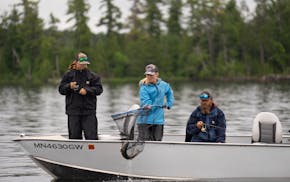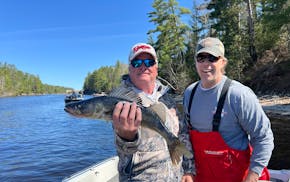President Donald Trump didn't mention wolves in his inauguration speech on Monday. But that doesn't mean change isn't coming in the way these apex predators are managed.
With the help of the Republican-controlled Congress, such a change is possible, if not probable. Whether deer numbers in northern Minnesota increase as a result, addressing the frustrations of whitetail hunters in that part of the state, is another question.
Either way, the Trump administration is likely to accelerate removal of Minnesota's (and Wisconsin's and Michigan's) wolves from protection under the Endangered Species Act (ESA), where they are listed as threatened, and return them to state management.
That should have occurred years ago, because wolves in the three states have surpassed population recovery targets set under the ESA. But wolves have gained a lot of friends in recent decades, making politics, not biology or policy integrity, the major force driving their management.
To that point, it's far from certain that, even if the Department of Natural Resources regains management of the state's estimated 2,900 wolves — the most in the Lower 48 — Minnesota wolf hunting and trapping would be restarted.
That's in part because Gov. Tim Walz and Lt. Gov. Peggy Flanagan have said they oppose wolf hunting and trapping. Both qualified their opposition during their 2022 campaigns, saying they supported the DNR's updated wolf management plan. But the plan doesn't guarantee that wolf hunting and trapping will get another run in the state. And unlike Wisconsin, Minnesota law doesn't require the state to initiate wolf taking if management is returned to the state by the feds.
The last time Minnesota allowed wolf hunting and trapping was 2012-2014, when 413, 238 and 272 wolves were killed in the three years, respectively.
Among Minnesotans who hunt deer in the north, including many from the Twin Cities, wolf management remains a hot topic. A recently formed group, Hunters for Hunters, held as many as 20 meetings beginning in December 2023 that in some cases attracted overflow crowds. Attendees complained that, along with low deer numbers, much of the state's whitetail hunting tradition was being lost, as were investments in hunting camps and properties.
More Hunters for Hunters meetings are planned this winter, beginning this weekend in Detroit Lakes.
In hunters' quest to return limited wolf hunting and trapping seasons to Minnesota, they've found allies among some moose advocates. Wolves are a primary predator of moose calves, and some big game managers believe targeted wolf hunting and trapping in the northeast could aid the state's struggling moose population.
How much, if any, deer might benefit from wolf hunting and trapping in Minnesota's special northeast moose management zone is unknown. In that region, higher deer numbers aren't a goal, or even desired, because whitetails carry brainworm, a parasite that doesn't affect them but kills moose. Unclear aș well is whether, absent successive mild winters, limited wolf hunting and trapping would significantly boost deer numbers anywhere in the north.
Meanwhile, preliminary statewide harvest numbers from last fall's hunts suggest about 170,000 whitetails were felled by firearm, archery (including crossbow) and muzzleloader hunters, a 7% increase from 2023 but 4% below the 10-year mean.
The size of the increase was a bit of a surprise, said DNR big game coordinator Todd Froberg, because hunter opportunity measured by the number of antlerless (doe) permits the DNR issued, along with other regulatory changes the agency made, should have only marginally increased the kill.
"By limiting antlerless permits somewhat and making other harvest restrictions, we wanted to build on the deer population increases that likely occurred during the mild winter of 2023-2024," Froberg said. "We expected a slight harvest increase this season. But it was larger than we thought it would be."
An even larger percentage kill was recorded last fall in the northeast, where 9% more deer were felled than in 2023 (still, the 2024 harvest remained 32% below the five-year mean).
Understanding exactly why the harvest increased that much is challenging. A possible reason is that generally mild weather prevailed throughout the season, meaning more hunters could hunt longer. Another possible reason is that slightly more deer hunting licenses were sold this season than last.
While it's possible, Froberg said, that a higher harvest was recorded because more deer were on the landscape, experience suggests that northern Minnesota whitetail populations don't rebound significantly in one year. The DNR, for example, has restricted hunter harvest in some parts of the northeast to bucks only for five consecutive years without noticeably boosting deer numbers. Severe winters during the period, marked by high deer mortality due to starvation, wolf predation and other causes, might explain the depressed harvests.
Additionally, even though deer and wolf numbers rise and fall more or less in sync, wolves, it appears, can sustain themselves at higher population levels, at least for a time, absent proportionate numbers of deer to prey upon. This population imbalance, however short-lived, might help explain why deer are having trouble rebounding in the northeast.
This from a recent Voyageurs Wolf Project study in northern Minnesota:
"[While] winter 2023–2024 would not have been sufficient to induce deer population declines, it is possible that wolf predation might influence how quickly low-density deer populations can grow and recover after severe winters. For instance, we suspect wolf population density remains stable in the months following severe winters because most wolves are in superb physical condition from the abundance of vulnerable deer during winter. Thus, wolf populations likely do not exhibit an immediate numerical response to changes in deer populations but rather likely lag behind deer populations for a period. As a result, it is conceivable that wolf populations could reduce, even in mild winters, the speed at which deer populations recover because of a one- to two-year lag in the numerical response of wolves."
The same research indicates that because wolf predation of deer in mild winters is significantly reduced, this winter, which is essentially snowless across the north, could be — if it continues temperate — the second in a row to benefit deer — and, possibly, hunters.
Finally, we should consider one other factor probably affecting deer numbers in the north — timber cutting — and whether it's occurring in concert with best-management practices for deer and other wildlife.
More on that in future columns.

Anderson: In early June, Minnesota fish are begging to be caught. Won't you help?

Anderson: Tails wagging, DNR officers' dogs find lost people and missing evidence
Anderson: Punish poachers more
Anderson: The Chainsaw Sisters Saloon is gone, but the Echo Trail is still a pathway to possibilities


